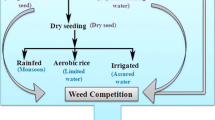Abstract
Direct-seeding of rice involves establishing crop from seeds sown in the field rather than by transplanting seedlings from the nursery. Water stress is one of the main environmental stresses responsible for reducing crop productivity as it affects growth through various biochemical and metabolic processes of plant. In rice, the effect of drought varies with the variety, degree and duration of stress and its coincidence with different growth stages. In the present study, recombinant inbred lines obtained from a cross between PR 120 × UPLRi 7 were used to study biochemical traits from leaves and harvested seeds under two sowing conditions i.e. direct-seeded aerobic condition and transplanted conditions. In general, the contents of total soluble sugar and starch in the leaves were higher under direct-seeded aerobic conditions at both vegetative and reproductive stages. While proline content at vegetative stage, was higher in transplanted crop than that of direct-seeded aerobic conditions. However, at reproductive stage, proline content was higher in aerobic crop which may be because of water stress. Storage protein in seeds was higher in direct-seeded aerobic conditions. But there was non-significant difference in total free amino acid in both the aerobic and transplanted conditions. However, there was a significant difference for all the biochemical traits among RILs under both sowing conditions.
Similar content being viewed by others
References
Farooq M, Kadambot HM, Siddique H, Rehman T, Aziz Dong-** Lee, Wahide A (2011) Rice direct seeding: experiences, challenges and opportunities. Soil Tillage Res 111:87–98
Anonymous (2012) Package of practices, Punjab Agricultural University, Ludhiana
Lowry OH, Rosenbrough NJ, Farr AL, Randell RJ (1951) Protein measyrement with folin-phenol reagent. J Biol Chem 193:265–275
Lee YP, Takahashi T (1956) An improved calorimetric determination of amino-acids with the use of ninhydrin. Ann Biochem 14:71–77
Dubois M, Giles KA, Hamilton JK, Roberes PA, Smith F (1956) Colorometric method for determination of sugars and related substances. Anal Chem 28:350–356
Bates LS, Waldren R, Pand-Teare ID (1973) Rapid determination of free proline for water stress studies. Plant Soil 39:205–207
Cochran WG, Cox GM (1967) Experimental design. Wiley, England
Bray FA (1993) Molecular responses to water deficit. Plant Physiol 103:1035–1040
Boyer JS (1976) Water deficit and photosynthesis. In: Kozlowski TT (ed) Water deficits and plant growth, vol 4. Academic Press, New York, pp 153–190
Boyer JS (1982) Plant productivity and environment. Science 218:443–448
Bell DT, Miller RJ, Koeppe DE (1971) The effects of drought stress on respiration of isolated corn mitochondria. Plant Physiol 48:413–415
Good AG, Zaplachinski ST (1994) The effect of drought stress on free amino acid accumulation and protein synthesis in Brassica napus. Physiol Plant 90:9–14
Sprent JI (1981) Nitrogen fixation. In: Paleg LG, Aspinall D (eds) Physiology and biochemistry of drought resistance in plants. Academic Press, Sydney, pp 131–144
Dwivedi DK, Kumar A, Mishra VK, Dwivedi S (2012) Phenotypic correlation and path coefficient analysis in rice (Oryza sativa L.) introgression lines under drought and controlled conditions. Int J Curr Res 4:7–12
Mai MAB, Shamsuddin ZH, Wahab Z, Marziah M (2010) Effect of plant growth and nitrogen incorporation of tissue-cultured Musa plantlets under nitrogen free hydroponics condition. Aus J Crop Sci 4:85–90
Roy R, Mazumder PB, Sharma GD (2009) Proline, catalase and root traits as indices of drought resistance in bold grained rice (Oryza sativa) genotypes. Afr J Biotech 8:6521–6528
Subbrao GV, Chauhan YS, Johannsen C (2000) Patterns of osmotic adjustment in pigeonpea- its importance as a mechanism of drought resistance. Eur J Agron 12:239–249
Ismail AM, Ella ES, Vergara GV, Mackill DJ (2009) Mechanisms associated with tolerance to flooding during germination and early seedling growth in rice (Oryza sativa). Ann Bot 103:197–209
Mullet JE, Whitsitt MS (1996) Plant cellular responses to water deficits. Plant Growth Regulator 20:119–124
Singh KP, Singh K (1983) Influence of stimulated water stress on free proline accumulation in Triticum aestivum L. Indian J Plant Physiol 26:319–321
Mattana M, Bertani A, Aurisano N, Reggiani R (1993) Preliminary evidence of nitrate assimilation during the anaerobic germination of rice. In: Jackson MB, Black CR, (eds) Interacting stresses on plants in a changing climate, 16, Springer, Berlin, NATO ASI Series 116: pp. 365–374
Acknowledgments
The authors wish to thank Dr. M. Javed, Dept of Math. Stat. and Physics, PAU, Ludhiana for help in computing the data.
Conflict of interest
The authors declare that they have no conflict of interest.
Author information
Authors and Affiliations
Corresponding author
Rights and permissions
About this article
Cite this article
Cheema, A.K., Bedi, S., Sahi, G.K. et al. Biochemical Characterization of a RIL Population of Rice (Oryza sativa L.) Under Direct-Seeded Aerobic and Transplanted Conditions. Proc. Natl. Acad. Sci., India, Sect. B Biol. Sci. 85, 1087–1093 (2015). https://doi.org/10.1007/s40011-015-0528-7
Received:
Revised:
Accepted:
Published:
Issue Date:
DOI: https://doi.org/10.1007/s40011-015-0528-7




